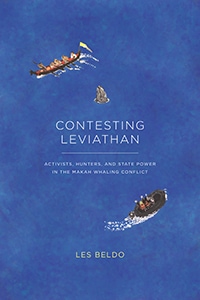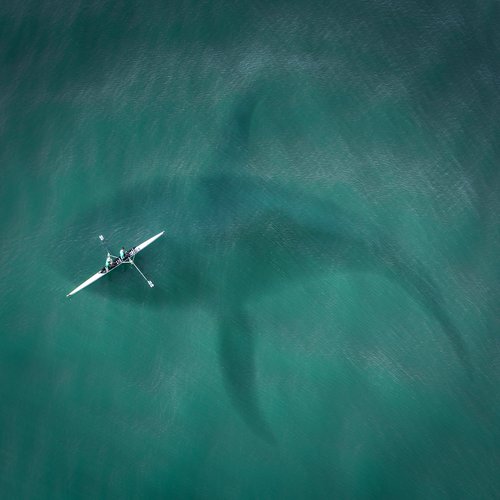In Contesting Leviathan, a reference on both the mythical sea-serpent and Thomas Hobbes’ political philosophy, Les Beldo seeks to provide a multi-faceted view of the Makah whaling conflict, a legal struggle between the indigenous Makah of North-Western United States, the US Government, and anti-whaling activists that has been ongoing since the early 1990s. He does this effectively by taking an in-depth look at all the parties involved in the conflict, humans and whales alike. Beldo conceives the practice of whaling not just as a means of subsistence for the Makah, but as the cornerstone of differing moral frameworks between the involved parties. The conflict is seen as a “story of translation, of the strategic adaptation of the discourses and practices to fit a dominant interpretative framework” (p.6).
 A key feature of Beldo’s ethnography lies in his attempt to decenter the human in his discussion and to present each party’s views in an equal and balanced way. Beldo demonstrates that the Makah whaling conflict goes beyond the simple struggle of an indigenous group in performing their traditional practices, and that all parties involved – the Makah, the activists, the state, and even the grey whales themselves – represent complex entities in the practice of Makah whaling. The first half of the book focuses on the Makah and the role of whaling in their indigenous lifestyle, as well as the place of the grey whale in Makah culture and spirituality. The second half of the book presents the other parties involved in the conflict – the state, the activists, and the whales. What is important to note is that these two sections are by no means distinct from each other. That is, Beldo is able to maintain the connections between all the parties involved in the conflict throughout the book, illustrating how strongly imbricated these relationships are with and how they collectively contribute to the production of the discourse on Makah whaling.
A key feature of Beldo’s ethnography lies in his attempt to decenter the human in his discussion and to present each party’s views in an equal and balanced way. Beldo demonstrates that the Makah whaling conflict goes beyond the simple struggle of an indigenous group in performing their traditional practices, and that all parties involved – the Makah, the activists, the state, and even the grey whales themselves – represent complex entities in the practice of Makah whaling. The first half of the book focuses on the Makah and the role of whaling in their indigenous lifestyle, as well as the place of the grey whale in Makah culture and spirituality. The second half of the book presents the other parties involved in the conflict – the state, the activists, and the whales. What is important to note is that these two sections are by no means distinct from each other. That is, Beldo is able to maintain the connections between all the parties involved in the conflict throughout the book, illustrating how strongly imbricated these relationships are with and how they collectively contribute to the production of the discourse on Makah whaling.
Chapter One looks at the history of whaling for the Makah. It takes a close look at the claim that for the Makah, the right to whale represents a reaffirmation of identity and sovereignty. In this chapter, Beldo takes apart the argument according to which the practice of whaling is fully representative of the Makah as a tribe. While not all Makah are whalers, most support the right of the Makah to engage in whaling as a means of asserting the rights given to them by the 1855 Treaty of Neah Bay. Whaling is a part of the tribe’s history and culture, and whales feature heavily in their spirituality and iconography, but Beldo shows that among the Makah, whaling is also the hereditary right of an elite. Whalers who come from old whaling families have different views on whaling than those who have become whalers after having accessed modern technologies like motorboats and spearguns. The chapter highlights the fact that even within the Makah, attitudes toward whaling differ greatly.
A key feature of Beldo’s ethnography lies in his attempt to decenter the human in his discussion and to present each party’s views in an equal and balanced way. Beldo demonstrates that the Makah whaling conflict goes beyond the simple struggle of an indigenous group in performing their traditional practices, and that all parties involved – the Makah, the activists, the state, and even the grey whales themselves – represent complex entities in the practice of Makah whaling.
Chapter Two takes a specific look at whaling as a means of subsistence for the Makah. Beldo highlights how the term “Yum!” is used by the Makah when referring to the grey whale and is representative of the overall role of the whale in the Makah foodways. “Yum!” refers to how the Makah often respond when asked about the grey whale, a statement intended to play upon the moral value associated with eating whales. As Beldo notes, it is “as if to say, ‘Yes, we kill animals, do you have a problem with that?’” (p.63) However, he also points out that it is a rather subversive notion when compared to non-Makah’s views of the inedibility of whales. However, for the Makah, grey whales are not seen as a high-value food. The grey whale is not the most preferred whale in terms of palatability – this goes to the humpback whale. The grey whale does not feature heavily in the daily diets of the Makah. So why does hunting it is so important to the Makah? The following chapter provides elements of answer to this question by discussing how politics, identity, and food intersect.
Chapter Three examines the role of the whale in the spirituality of the Makah. A key point to note is the notion that Makah spirituality is best characterized by its variability. Each member of the Makah may have their own set of spiritual beliefs and practices. For example, some whalers believe that the spirituality of whaling lies in the relationship between the hunter and the whale, which justifies the use of more modern equipment in their hunting. On the other hand, there are those who believe that the traditional method of using canoes and harpoons highlights the spirituality embedded in the practice of the hunt itself. Both are equally valid expressions of spirituality in the community. Beldo argues that these variable spiritual views best explain the differences in how the Makah approach non-human animals, in hunting and other contexts like pets. Chapter Four looks at the role of the state, in this case the National Marine Fisheries Service (NMFS), in the whaling conflict. With the realization that the NMFS holds the greatest political power in the whaling conflict, Beldo argues that a “moral consonance” between the Makah and the NMFS allows the Makah to successfully push forward their goals with regard to their fishing rights. The Makah accomplish this by “translating” their goals into a familiar language for the NMFS, changing the discourse from tradition, culture, and practice to the logics of fisheries’ management.
Chapters Five and Six provide an account of whaling activists’ perspectives. The first part details the origins and history of the anti-whaling movement in Washington state, along with the apparent failure of what Beldo calls its initial “interventionist approach ”. This approach is best captured in early attempts by activists to protest whaling activities by using their own boats to physically interfere, which only led to their arrests by the US Coast Guard. By fighting against both the Makah and the state, the activists were unable to gain ground in the conflict. However, in the next section, Beldo shows that when Makah activists embrace the language of the NMFS and focus on legislative reforms, they begin to be more successful. This, however, comes with a cost: by “speaking the language” of the NMFS, activists are forced to abandon their initial moral positions on whales. Their discourse shifts from a focus on aesthetics and whales’ rights to arguments related to ecological stock. In doing so, Beldo sends a bleak but powerful message: eliciting change in the policies of the federal government will often entail the need to embrace the inherent moral beliefs of that system, which can often be at the cost of indigenous moral beliefs.
Chapter Seven seeks to capture the grey whale’s perspective. While it is impossible to get a first-hand account from the grey whale, Beldo looks at the different interpretations of one particular grey whale’s unusual behavior whoapproaches fishing boats. For the Makah, the approach of the whale signifies its consent to being hunted. For activists, it demonstrates whales’ prosocial behaviour. It is important to note that for Beldo, these interpretations of whales’ behavior are attempts to speak for the whale rather than with them. This chapter reflects anthropology’s current concern for “decentering the human”, by placing greater emphasis on the role that non-humans play in cultural phenomena.
Their discourse shifts from a focus on aesthetics and whales’ rights to arguments related to ecological stock. In doing so, Beldo sends a bleak but powerful message: eliciting change in the policies of the federal government will often entail the need to embrace the inherent moral beliefs of that system, which can often be at the cost of indigenous moral beliefs.
Overall, Contesting Leviathan is a well-argued and well-researched volume. Beldo demonstrates great reflexivity and acknowledges his positionality as a white non-member of the Makah. However, his position as an outsider enables him to present the views of the various actors involved in the conflict. His interactions with the Makah and the activists are both intimate and well-informed, providing excellent context for his argument. The book displays a few illustrations, which contribute strongly to the book’s discussion. Portraits of people as well as historical photos of the Makah whale hunts provide vivid insights into Makah culture and society. Contesting Leviathan is recommended reading for those interested in a good case study of indigenous groups’ claims for their cultural rights. It provides an original take on food, politics, and identity, and on non-human forms of agency.
Featured Image by SarahRichterArt, pixabay.com.



